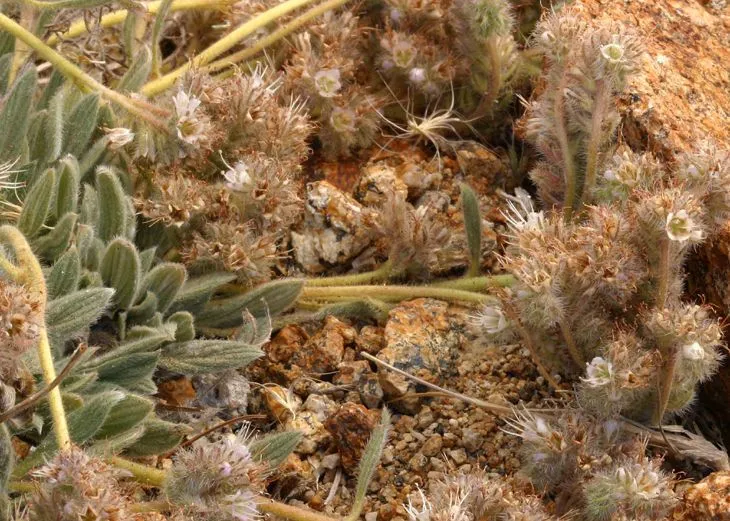
Author: Dougl. ex Lehm.
Bibliography: Nov. stirp. pug. 2:20. 1830
Year: 1830
Status: accepted
Rank: species
Genus: Phacelia
Vegetable: False
Observations: W. Canada to W. & NC. U.S.A.
Silverleaf phacelia, scientifically known as Phacelia hastata, belongs to the Boraginaceae family. This resilient plant has been documented as early as 1830, with the initial description provided by Douglas and Lehmann in the work “Novarum Stirpium Pugillus.” Native to Western Canada and spanning across the Western to North-Central regions of the United States, Silverleaf phacelia is well-regarded for its hardiness and adaptability to various climates.
Phacelia hastata is renowned for its striking silver-green foliage and delicate, bell-shaped flowers that range from a subtle blue to deep violet hue. The plant typically thrives in rocky, dry soils, often found in open woodlands and sagebrush steppe environments. As a member of the diverse Boraginaceae family, its floral structure is notably characteristic, providing ecological value as it attracts a myriad of pollinators including bees and butterflies.
The Silverleaf phacelia holds not only aesthetic appeal but also ecological significance. It contributes to soil stabilization and offers valuable habitat for wildlife. Gardeners and plant enthusiasts often seek out Phacelia hastata for native plant gardens and xeriscaping due to its drought tolerance and minimal maintenance needs.
In conclusion, Silverleaf phacelia (Phacelia hastata) is a noteworthy species within the Boraginaceae family. Its historical significance, coupled with its robust nature and ecological contributions, make it a plant of considerable interest and value.
Eng: silverleaf phacelia, silver-leaved phacelia, silver-leaved scorpionweed
Fra: phacélie hastée
En: Silverleaf phacelia, Silver-leaved phacelia, Silver-leaved scorpionweed
Fr: Phacélie hastée
Taken Jul 8, 2021 by Mars (cc-by-sa)
Taken Jul 8, 2021 by Mars (cc-by-sa)
Taken Oct 14, 2019 by Maya J (cc-by-sa)
Taken Aug 12, 2022 by NotRealyHere OrThere (cc-by-sa)
Taken Jul 19, 2020 by randa keys (cc-by-sa)
Taken Sep 2, 2012 by EOL − Genevieve K. Walden (cc-by-sa)
Taken Feb 2, 2014 by EOL − Genevieve K. Walden (cc-by-sa)
Taken Aug 31, 2004 by EOL − Steve Matson (cc-by-nc)
Taken Jun 28, 2020 by Steph Hogan (cc-by-sa)
Taken Sep 24, 2020 by correa cristian (cc-by-sa)
Taken Aug 31, 2004 by EOL − Steve Matson (cc-by-nc)
Taken Aug 31, 2004 by EOL − Steve Matson (cc-by-nc)
Taken Dec 1, 1998 by EOL − Charles Webber (cc-by-nc-sa)
Taken Feb 1, 2010 by EOL − Keir Morse (cc-by-nc-sa)
Taken Feb 1, 2010 by EOL − Keir Morse (cc-by-nc-sa)
© copyright of the Board of Trustees of the Royal Botanic Gardens, Kew.
Growth form>: Bunch
Growth habit>: Forb/herb
Growth rate>: Moderate
Ph maximum: 7.3
Ph minimum: 6.1
Family: Myrtaceae Author: (F.Muell.) K.D.Hill & L.A.S.Johnson Bibliography: Telopea 6: 402 (1995) Year: 1995 Status:…
Family: Rubiaceae Author: Pierre ex A.Froehner Bibliography: Notizbl. Bot. Gart. Berlin-Dahlem 1: 237 (1897) Year:…
Family: Sapindaceae Author: Koidz. Bibliography: J. Coll. Sci. Imp. Univ. Tokyo 32(1): 38 (1911) Year:…
Family: Asteraceae Author: A.Gray Bibliography: Pacif. Railr. Rep.: 107 (1857) Year: 1857 Status: accepted Rank:…
Family: Fabaceae Author: Medik. Bibliography: Vorles. Churpfälz. Phys.-Ökon. Ges. 2: 398 (1787) Year: 1787 Status:…
Family: Aspleniaceae Author: (Cav.) Alston Bibliography: Bull. Misc. Inform. Kew 1932: 309 (1932) Year: 1932…